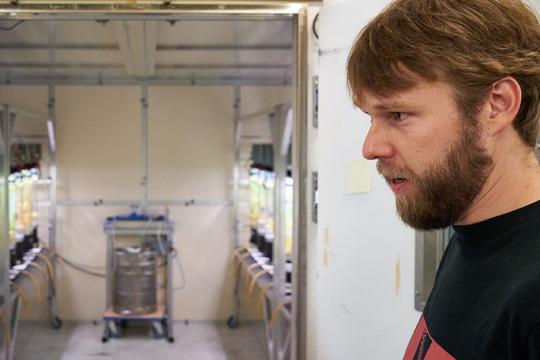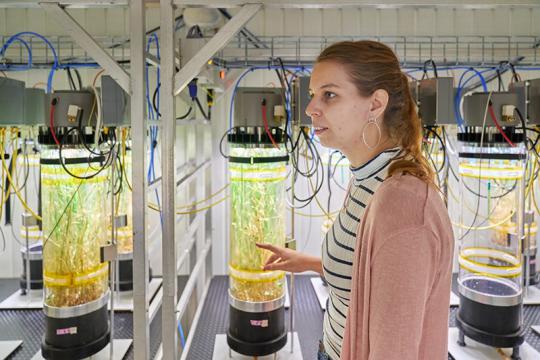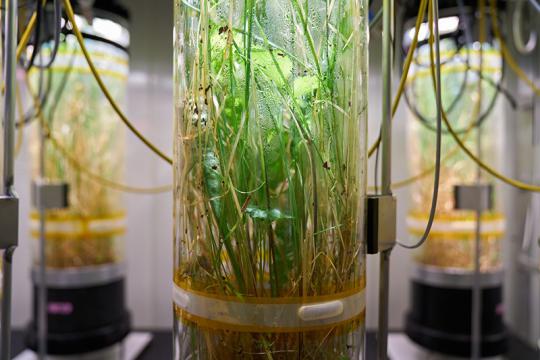Those lit pipes with grass in them, that is Climecs. It is an unusually ecological research lab, hidden in the basement of the W&N building. And yes, Climecs has something to do with climate change. The lab contains 40 ‘columns’, as the researchers call them. There is a piece of pasture in each column and ecologists from the VU are experimenting with it. They can vary the temperature, precipitation and light intensity per column and see what the effect of this is on the biodiversity in the mini-ecosystem in the column.

“I was doing PhD research into the effects of heat waves on biodiversity, but the climate chambers that VU Amsterdam had were not suitable for that,” says Oscar Franken, who is now scientific coordinator for a project of the University of Groningen on Texel. “Those labs are designed to keep the climate very constant, and they start to falter at temperatures above thirty degrees. But for me it only started there.”
Test new crops
So, together with the workshop for electronics and precision mechanics, Franken built this dynamic climate chamber. And now he is also trying to market his climate columns. “We hope that there will be parties who want to install such a lab themselves or do experiments at VU Amsterdam.”
He is currently talking with other academic institutions. “But it can also be interesting for agricultural technology. Companies working on seed breeding can test their newly developed crops in this.”

Michella Ligtelijn is currently doing an experiment in the climate columns for her master’s study in ecology. “I sprayed these soil samples in three different concentrations with pesticides that are frequently used in potato cultivation, among other things. This type of pesticide is associated with the bee colony mortality. Afterwards, I check how many springtails the bottom contains, small soil animals. In my columns with a healthy soil there are as many as five hundred each.”
Dead springtails
A week after spraying, Ligtelijn emptied half of the columns for analysis. “I can already say: the agricultural poison goes into the ground,” she says cheerfully, “and there is death: some of the springtails die from the substance.”
She has to count all those creatures through the microscope to find out how high the mortality is. “Now, nearly two months have passed since the spraying, and next week I will remove the soil samples that are still here for analysis. I expect to count a total of 25 thousand springtails.”

Each column contains a piece from a large meadow near Wageningen, which is kept as clean as possible. Everything is in it: plants, fungi, bacteria, springtails, and also worms. “Those brown spots on the glass come from worms”, Ligtelijn points out. “If the soil gets too dry, they come up and this is left behind. This morning I saw a few, let’s have a look. No, they are gone. ”
Franken, peering into another column: “Here, woodlice, is that something for a photo?” But they are too hard to see.
It is raining
In this experiment, Ligtelijn tries to imitate the natural conditions in the Netherlands as closely as possible. “I let it rain twice a week,” she says. “Fifty milliliters, based on what falls on average in the Netherlands in a year. In reality there is more variation in the weather and in the soil, but I see that the variation is less within the columns that have had the same treatment than between them, so that’s good.”
And, she adds, this experiment is with only one toxic substance. “In reality, farmers use a mix and those substances often reinforce each other in a negative way. Little is being tested on this, so there is still plenty to do.”
